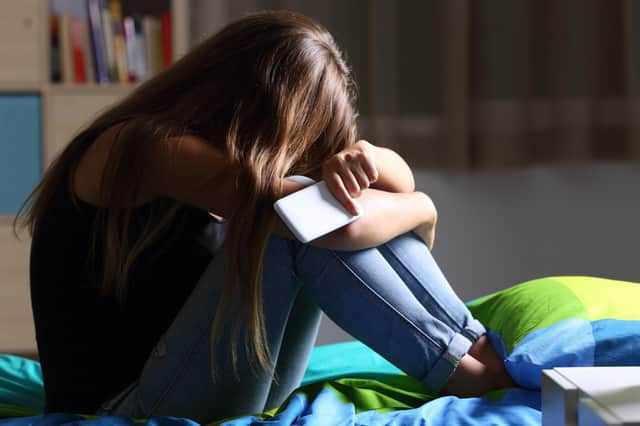More than 15,600 child abuse image crimes recorded by police in Yorkshire and Humber


NSPCC put in Freedom of Information requests to police forces across the UK asking for the for the number of Indecent Images of Children offences recorded by police for the years 2018/19 to 2020/21
Data from forces in the Yorkshire region relating to possessing, taking, making, and distributing child abuse material in the Yorkshire and the Humber peaked at 3,659 last year (2020/21) – up 59 per cent from 2016/17.
Advertisement
Hide AdAdvertisement
Hide Ad15,644 offences were recorded by police forces in Yorkshire and the Humber across the five years
There was a seven per cent increase in offences in the first year of the pandemic, from 2019/20 to 2020/21
In West Yorkshire, the total of offences recorded across the five years was 7,181.
This is 46 per cent of the total offences in the region.
Across the UK, offences recorded by police passed 100,000 in the five years, with more than 25,000 crimes last year - up 37 per cent since 2016/17.
Advertisement
Hide AdAdvertisement
Hide AdThe NSPCC said social media is being used by groomers as a conveyor belt to produce and share child abuse images on an industrial scale.
They added that the issue of young people being groomed into sharing images of their own abuse has become pervasive.
Ben* was 14 when he was tricked on Facebook into thinking he was speaking to a female friend of a friend who turned out to be a man.
Using threats and blackmail he coerced Ben into sending abuse images and performing sex acts live on Skype.
Advertisement
Hide AdAdvertisement
Hide AdThe images and videos were shared with five other men who then bombarded Ben with further demands.
His Mum, Rachel*, said: “The abuse Ben suffered had a devastating impact on our family. It lasted two long years, leaving him suicidal.
“It should not be so easy for an adult to meet and groom a child on one site then trick them into livestreaming their own abuse on another app, before sharing the images with like-minded criminals at the click of a button.
“Social media sites should have to work together to stop this abuse happening in the first place, so other children do not have to go through what Ben did.”
Advertisement
Hide AdAdvertisement
Hide AdThe NSPCC is now urging Culture Secretary Nadine Dorries to seize the opportunity to strengthen the Online Safety Bill, so it results in decisive action that disrupts the production and spread of child abuse material on social media.
Ahead of a report by Parliamentarians who scrutinised the draft Online Safety Bill expected next week, the NSPCC, which has been at the forefront of campaigning for social media regulation, set out a five-point plan to strengthen the legislation so it effectively prevents online abuse.
The charity’s online safety experts said the Bill currently fails to address how offenders organise across social media, doesn’t effectively tackle abuse in private messaging and fails to hold top managers liable for harm or give children a voice to balance the power of industry.
The NSPCC is critical of the industry response to child abuse material.
Advertisement
Hide AdAdvertisement
Hide AdNSPCC Chief Executive, Sir Peter Wanless, said: “The staggering amount of child sexual abuse image offences is being fuelled by the ease with which offenders are able to groom children across social media to produce and share images on an industrial scale.
“The Government recognises the problem and has created a landmark opportunity with the Online Safety Bill. We admire Nadine Dorries’ declared intent that child protection is her number one objective.
“But our assessment is that the legislation needs strengthening in clear and specific ways if it is to fundamentally address the complex nature of online abuse and prevent children from coming to avoidable harm.”
The NSPCC’s five-point plan:
Disrupt well-established grooming pathways
The Bill fails to tackle convincingly the ways groomers commit abuse across platforms to produce new child abuse images.
Advertisement
Hide AdAdvertisement
Hide AdOffenders exploit the design features of social media sites to contact multiple children before moving them to risky livestreaming or encrypted sites.
The Bill needs to be strengthened to require platforms to explicitly risk assess for cross platform harms.
Tackle how offenders use social media to organise abuse
The Bill fails to address how abusers use social media as a shop window to advertise their sexual interest in children, make contact with other offenders and post digital breadcrumbs as a guide for them to find child abuse content.
Recent whistle-blower testimony found Facebook groups were being used to facilitate child abuse and signpost to illegal material hosted on other sites.
Advertisement
Hide AdAdvertisement
Hide AdPut a duty on every social media platform to have a named manager responsible for children’s safety
To focus minds on child abuse every platform should be required to appoint a named person liable for preventing child abuse, with the ultimate threat of criminal sanctions for product decisions that put children in harm’s way.
Give the regulator more effective powers to combat abuse in private messaging
Private messaging is the frontline of child abuse but the regulator needs clearer powers to take action against companies that don’t have a plan to tackle it.
Advertisement
Hide AdAdvertisement
Hide AdCompanies should have to risk assess end-to-end encryption plans before they go ahead so the regulator is not left in the dark about abuse taking place in private messaging.
Give children a funded voice to fight for their interests
Under current proposals for regulation children who have been abused will get less statutory protections than bus passengers or Post Office users.
There needs to be provision for a statutory body to represent the interests of children, funded by an industry levy, in the Bill.